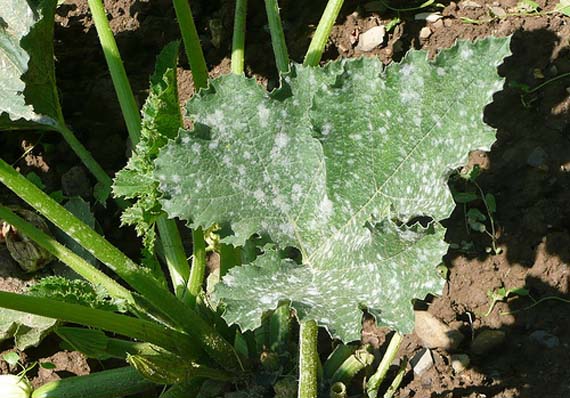
Whitish spots: First symptoms of powdery mildew
Powdery mildew, ash, dust, dust, ash, cendrada, sendrosa, sendreta, malura vella, blanqueta, etc. Depending on the place, it is known by a name, but all respond to this fungus (Uncinula necator) that covers the leaves with a gray or white coating similar to ash. As the disease progresses, the leaves turn yellow and dry out.
It is typical of times with mild temperatures and high humidity. Melons, cucumbers, watermelons and zucchini are affected by it in spring. Cabbages and chard suffer it in autumn. So now that we start with our flowerpot Autumn, beware of powdery mildew as soon as the temperature begins to drop and the humidity rises.
La mediterranean area it is one of the areas most prone to powdery mildew. High humidity, low temperature, poor ventilation, low light levels, stale air and even excess nitrogen favor its spread. A very high plant density in our urban garden it makes aeration difficult and can be a determining factor for the proliferation of this fungus.
For prevent its appearance we will avoid puddles and sources of dirt, we will favor ventilation and aeration between the different plants and we can apply weekly sprays of propolis on the leaves (3 ml. per liter of water), which also acts as a fungicide against other fungi and bacteria and increases the plant's defenses. The horsetail preparations y it they are also excellent preventatives.
Once we detect the first symptoms of the plague (appearance of whitish spots, as if it were dust) it is necessary to immediately eliminate the infected leaves and improve the aeration of the garden by pruning or eliminating some plants if there is a lot of density, as this fungus spreads quickly if the conditions are favorable. . If the powdery mildew advances, growth will slow down, the leaves will turn yellow and die.
For fight powdery mildew we can apply spray treatments on the leaves:
- skimmed milk (half a liter of milk for 8 of water). It is very effective.
- hydrogen peroxide diluted in water (75 ml for 5 l of water).
- sulfur, either in aqueous spray or in powder given with bellows (never in flowering).
More information - Potted chard, The flowerpot, Make an ecological fungicide at home, Making an insect repellent at home
Hi, I'm from Argentina, and I've had a few chard plants in my garden for a while, and I noticed that they began to turn white as if they had sprinkled ash or flour on their leaves. Two days ago the leaves below began to turn yellow. I wanted to know if it is powdery mildew? And if you can consume the leaves that are still green but stained with that white powder. And what should I do to treat it? Or if you would have to cut or remove the plants directly? I hope for answers soon.
Hi Lucia.
From what you say it does seem like powdery mildew. In these cases it is recommended to prune the affected parts to prevent the other plants from being infected, and to do treatments with garlic (50 grams in a liter of water) to combat it.
A greeting.
Thank you very much for your answer!. Now I have cut them to all the chard plants and I will see as they grow if it disappeared but as a precaution I will do what you recommended, thank you !.
Good afternoon. I have several questions regarding powdery mildew. I pass them on below
1.- What are the consequences for humans of consuming any vegetable / vegetable that has been infected by this fungus?
2.- How can the appearance of the fungus be prevented?
3.- The remedies they have given, how often do they need to be used? Is skim milk really effective? My question is if it is once a week, every day, ...
Thank you very much in advance for these explanations that you have given.
A greeting.
I request an answer by mail.
Hi carmen.
1.- You could have discomfort, diarrhea, stomach pain.
2.- The most effective way to prevent its appearance is by controlling the risks by checking the humidity of the soil before watering, and avoiding wetting the leaves, flowers and fruits.
3.- The remedies can be used once a week. With regard to skimmed milk, the truth is that I could not tell you because I have not tried it, but sulfur I can tell you that it is a powerful and very effective fungicide.
A greeting.